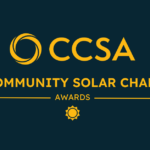Summit Ridge Energy’s 9.2-megawatt solar array on the roof of a Maryland commercial warehouse. (Courtesy: Summit Ridge Energy)
Hailing it as a milestone that will “bring us one step closer to a carbon-neutral future,” New York Gov. Kathy Hochul last week said the state now has more than one gigawatt of community solar installed — enough to serve 209,000 homes — as well as projects under construction that will serve 401,000 more.
The rapid growth in community solar markets like New York comes against a backdrop of unprecedented federal support: the U.S. Department of Energy’s goal to power five million households with community solar by 2025 and create $1 billion in energy bill savings. In January the DOE went a step further, launching initiatives like technical support and financing plans that are aimed at removing obstacles to deploying community solar.
Industry leaders see this federal support as validation of the important and growing role that community solar will play in the nation’s clean energy goals, and an acknowledgement of the industry’s unique ability to provide renewable energy savings to customers of all socioeconomic backgrounds.
“In achieving the administration’s goals, all communities deserve to benefit from the clean energy transition,” Kelly Speakes-Backman, Principal Deputy Assistant Secretary for the DOE Office of Energy Efficiency and Renewable Energy, said in a January statement. “Community solar is an essential element of expanding affordable solar energy access by allowing everyone to share in the benefits of clean energy regardless of whether their homes can support rooftop solar panels.”
The community solar industry is aligned with these goals and has committed to developing 20 GW of capacity by 2025.
But there is much work to be done to reach these targets. Challenges remain, such as interconnection problems, bureaucratic and financial red tape and opposition from utilities. Capacity must expand more in some states, costs for consumers must be lowered and projects must come online faster.
Only about 10 percent of generated electricity is solar and an even smaller portion is community solar. While 22 states and Washington, D.C. have state policies that support community solar deployment, nearly three-quarters of the market is concentrated in a handful of states. That leaves a lot of room for community solar to assert itself as part of the clean energy revolution.
Now, more community solar partners than ever are looking at how to close the gap between these ambitious federal goals and the ability of states to meet those goals within the existing framework.
The DOE’s National Community Solar Partnership (NCSP), a coalition that was created to advance the DOE’s goals, recently outlined pathways to unlocking more access to community solar around the country:
- A States Collaborative, made up of state energy officials and program administrators, to support expansion and development of new community solar programs at the state level. The program will offer best practices from industry leaders, technical assistance and opportunities for direct peer-to-peer learning.
- A Credit Ready Solar Initiative to help community solar developers access financing and create standard processes and a marketplace for deploying capital. This program will bring together lenders, philanthropic institutions and community solar developers, specifically those that are community-based or serve low- to moderate-income households, with the goal of making deals more transparent and accessible.
- A $2 million technical assistance program for NCSP partners that will provide personalized support to help accelerate implementation, improve the performance of programs or projects and build capacity for future community solar development.
- An acquisition tool aimed at streamlining the process of attracting new customers, specifically low- and moderate-income customers. The system will match recipients of other federally managed low-income programs with available community solar subscriptions with the goal of reducing energy costs for program participants and making it easier for developers to connect with potential subscribers.
- A messaging campaign targeting state and utility programs, as well as an educational campaign for customers who may not be familiar with community solar models to illustrate the benefits and cost-saving potential of the programs.
Industry leaders also remain optimistic about the possibility of the U.S. House and Senate passing clean energy provisions that were contained in the stalled Build Back Better Act. Those provisions would support the expansion of community solar by reducing energy bill costs and emissions, cutting the cost of installing rooftop panels, incentivizing domestic manufacturing for projects, improving grid resilience and creating jobs.
In the meantime, industry leaders are forging ahead. Summit Ridge Energy recently unveiled the nation’s largest rooftop community solar array, a 9.2-MW solar project in Maryland that will provide monthly energy savings to about 1,300 residential and small commercial customers across the state.
“This is a marquee project for Summit Ridge, our capital partners at Hannon Armstrong and the entire community solar industry,” said Steve Reader, CEO of Summit. “Leveraging 23 acres of largely unused roof space to generate energy savings for thousands of Marylanders is precisely the direction our nation’s energy generation strategy needs to head.”




